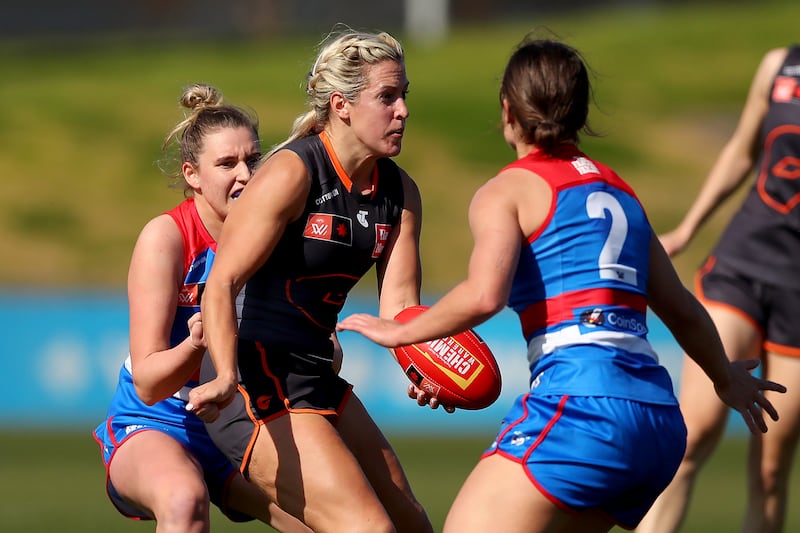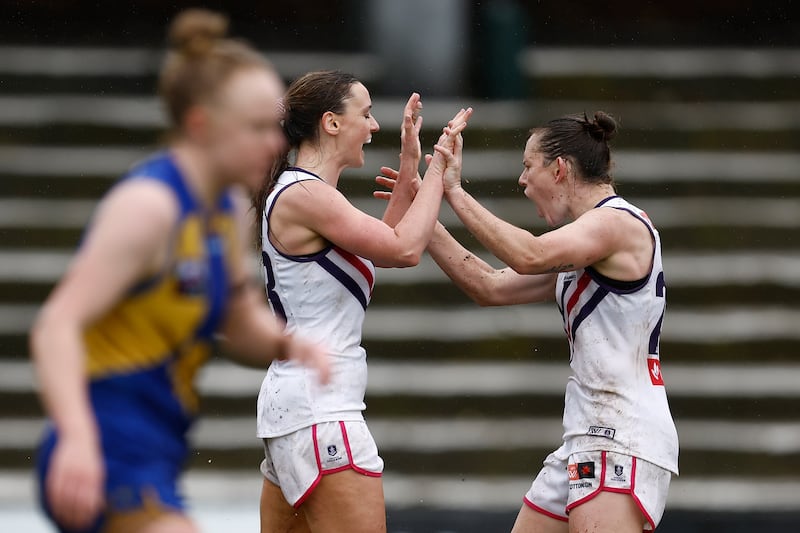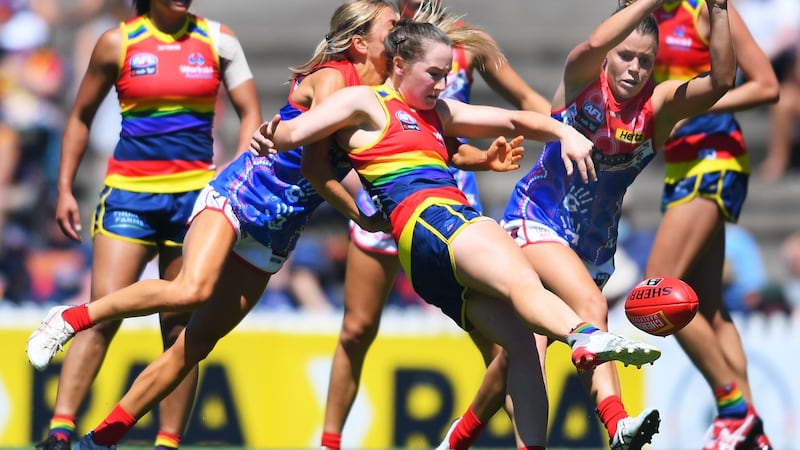In Melbourne, they’ve had the coldest winter in 70 years. The sky was low and grey on Wednesday afternoon, the temperature limped into the early teens before beating a hasty retreat. Everything is relative, though – for the gang of young women gathered in a city coffee shop, it looked and felt like a fairly routine Irish day. Fleece weather, at a push.
Connections. They came together to pass the time and swap stories. Some of them knew each other well, for others it was their first meeting. A few have lived in Australia on and off since the mid-2010s, some arrived a fortnight ago. All are there as part of a select band of sportswomen that was unthinkable less than a decade ago. Professional Aussie Rules players, preparing for the start of the new season.
“About 10 of us met up,” says Sarah Rowe, the Mayo player who is heading into her fifth campaign with Collingwood. “Grace Kelly was there, Aisling Sheridan, Erika O’Shea, Vikki Wall. Oh God, I’ll forget someone now – Aileen Gilroy, Clara Fitzpatrick, Áine McDonagh. We met up for coffee.
[ Next three years could see Irish involvement in AFLW peak and then fallOpens in new window ]
“It was so funny, Irish people all think the same way. Like, over here, everyone is so extremely positive. That’s the culture. You could sidestep a player and everyone would be cheering wildly for you. Whereas in Ireland, you either rip the piss out of someone or you wait until afterwards and quietly say, ‘That was very good.’ Like, the Irish attitude is that attack is the best form of defence. People would nearly be distrusting of you if you gave them too much praise.
Five Things We Learned from GAA Weekend: FRC have done a lot right but some rules need binning
Alarm bells are ringing about GAA hooters - good thing there’s an easy solution
Ireland v France: What time is kick-off and what TV channel is it on?
Who is Clayton McMillan and what can Munster fans expect from new coach?
“So we went for coffee and took the piss out of each other. That was what we talked about most, the difference in environments between Ireland and Australia. Just the people we are. I was loving it. I was looking around the table and thinking, ‘It’s so interesting to think of the fact that there will be 21 Irish players in the league this year.’ That’s a massive impact.”
It’s a phenomenon without precedent. There has never been a sports league anywhere in the world where 21 Irish women have been paid, contracted players. The seventh season of the AFLW starts next Thursday and runs until the last weekend in November. A dozen of the 16 teams will have Irish involvement, some of them among the best female Gaelic footballers of their generation.

Cora Staunton is on any shortlist of the greatest players the game has seen. Vikki Wall and Bríd Stack have both been Senior Player of the Year, Aisling McCarthy and Áine Tighe have taken the Intermediate award. Sinead Goldrick has been selected on seven All-Star teams. Rachael Kearns, Bláithín Mackin, Erika O’Shea and Aileen Gilroy are all recent All-Stars as well. The Aussie game is getting quality as well as quantity.
A good question to ask is why? Not so much why so many of them want to go – although we’ll get to that in a bit. More so why the AFLW is interested in Irish players in the first place?
Partly, it’s a numbers game. When the league started in 2017, it comprised of just eight teams and ran through February and March. It has doubled in size and timespan in just five years, requiring more players to fill out the rosters. The 16 teams will name 30-player squads – with injuries and replacements, there’s a need for close on 500 players over the coming four months. In that context, 21 Irish players maybe isn’t as many as it sounds.
But beyond the sheer pull of numbers, the Irish players are gradually adding value year on year. Staunton cracked the top 10 in the goalscoring charts last season, Orla O’Dwyer became the first Irish player to make the All-Australian team. Aisling Sheridan won Collingwood’s Best First Year Player award in 2020. Goldrick, Rowe and McCarthy are fixtures and team leaders at their clubs.
“Irish players bring a couple of things that are always commented upon,” Rowe says. “For one thing, we’re nearly all light-hearted and we don’t take life too seriously. Sometimes professional sport can be so po-faced and it can be a struggle to generate team bonding because nobody wants to be seen not putting the work in. The Irish approach to life is really appreciated in that nobody questions our work ethic but they can see we always bring people together and have a laugh too.
“On the playing side, we obviously have skills shortages to make up from the start. But the thing that trainers are always surprised and impressed by is the physical strength and endurance of Irish players. Gaelic football training makes you so fit and strong and the demands of top-level intercounty are so great that hard work is really bred into us.

“That’s something we would have a name for within the game. Like you’d often hear someone go, ‘Well, she hasn’t a clue how to kick or where to go but she won’t back down from a fight.’ That’s taken for granted among Irish girls. We’re seen as tough players.
“We don’t complain, which isn’t always the right thing for the team. In a professional environment, you’re wrong to just brush off a niggly injury and play through it. But that’s what you grow up doing in the GAA. You’re like, ‘Ah, I have a bit of a tight calf but it’ll be grand, I’ll run it off.’ We’ve all done it but it’s a lesson you learn the hard way.”
As for the flipside, the reasons Irish players go halfway around the world to play an alien game for four months aren’t straightforward. The money is far from life-changing but it’s getting better. There are four wage brackets, with a select band of top-tier players earning $71,935 (€49,255) for the season. Understandably enough, none of the Irish players are at that level.
At the lowest end of the scale, the salary is $39,184 (€26,830). Those figures show a significant rise since last season – that bottom bracket has almost doubled in size since April. The league is in a reasonably healthy state coming out of the pandemic and stated intention is for clubs to be full-time professional by 2026. Even so, nobody is heading to Australia to make their fortune.
In most cases, the challenge itself is the thing. With the odd exception, they’re all in their 20s. They’ve no big commitments tying them down and they don’t want to move onto the next phase of life leaving ‘what ifs’ behind them. The chance to test themselves is generally what brings them over initially, the opportunity to live the life of a professional athlete. Even just the adventure of it all.
“It is appealing to go over,” says Rowe. “Not only to learn a new sport, which comes with its own challenges and vulnerabilities. But it’s also character-building, the experience of learning a professional environment. Like, I adore Gaelic football and I would rather play it as a sport all my life if I could but the experience of learning and growing and developing as a person as I have done here since I first came is something that anyone would jump at.
“I can’t express enough my gratitude for the experience. How much I’ve learned as a person, how much I’ve learned as a player. We are in such a high performance environment here. We are surrounded by the male players, the male coaches, the same S&Cs experience that the male players get. Some of the men are among the best athletes in world sport.
“Every day we go into work, we are in a place where everybody is working towards making themselves the best they can be. You are surrounded by this so you are constantly evolving and growing. You are learning by watching. You are picking up small things that make players great. The experience of that is so good for Irish players to have in their lives and to get the chance to contribute to.”
The downside of it all is, of course, the effect of the Australian adventure on the LGFA here. Not all of the 21 players would be in Ireland today if the AFWL didn’t exist but most of them would. They’d be playing in club championships, they’d have played for their counties in the summer just gone. Some of them did. Some – Rowe among them – did not.
[ Michael Currane provides vital link between Irish wannabes and AFLWOpens in new window ]
The move of the AFLW season to this time of the year is a killer. When it was played in the Irish spring, everybody could be sure of getting back home in time for championship. With an August start from this year onwards, it means players are going to be forced to choose.
The AFLW pre-season starts in late June – that’s way too much of an overlap for Aussie clubs who are paying a wage to tolerate their investments playing championship football. Some clubs don’t let their players ski in the off-season. A full campaign of blood and thunder football isn’t going to fly.
“No one wants to step away from playing Gaelic football,” Rowe says. “Everybody wants to play for their county. It’s an absolute honour. I so badly wanted to play for Mayo this year but we just couldn’t make it work. It’s such a hard thing to not do. I want both but I can’t have both.
“And I completely understand why. Collingwood are paying me to play for them. I have been here for five seasons. We are working towards something special together. We all feel that. For me to go, ‘Yeah, that’s great but I’m not going to be here for pre-season…’ It just wouldn’t be right. You’re not preparing your body as best as you possibly can.

“I would be worried about it from an LGFA point of view. I do think it’s quite worrying. Right now, it’s just about possible for girls to play an inter-county season and maybe get signed up over here afterwards, especially with the four expansion teams this year. But in a couple of seasons, when it goes full-time professional here, there won’t be anybody going over and back. You will have to be one or the other.
“It’s such a shame. I wish there was a way around it. In my heart and soul, I am a GAA player. That’s what my identity is. I am a Gaelic footballer playing Aussie Rules. My love lies with the GAA. But my job is to be the best athlete I can be. It pulls at my heartstrings not to be able to play the game I grew up with but I also love what I’m doing.”
This weekend, it all kicks off again. As it happens, Rowe will miss Collingwood’s first-round game against Carlton, serving a one-game suspension hanging over from last season. “Cailín dána,” she tuts against herself. But all across Australia, from The Gabba in Brisbane to the Marvel Stadium in Melbourne, from Perth to Sydney to Adelaide, Irish players will be lacing up and hitting out and holding their own.
Whatever the future holds, it’s a remarkable thing.
















